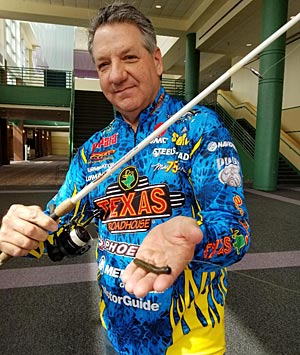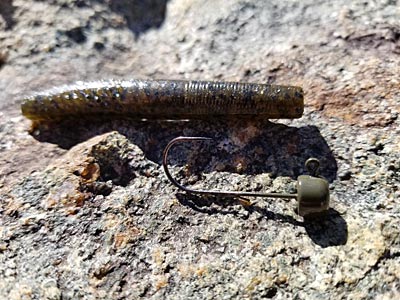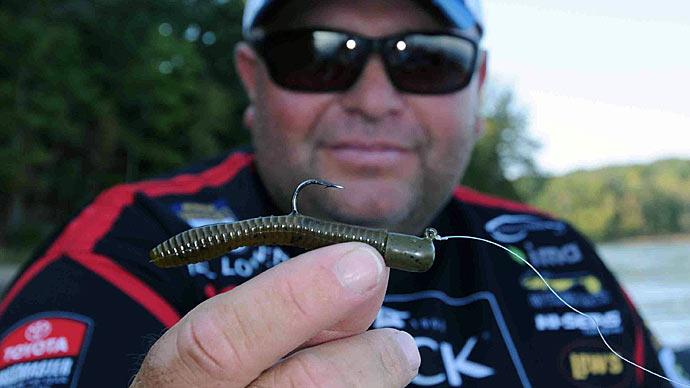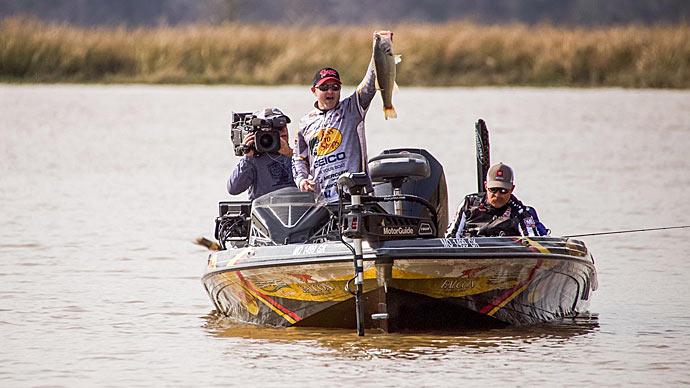
Plenty of new lures and techniques have come and gone since Mike DelVisco started his bass tournament and fishing seminar career about 30 years ago. And with more released through what seems like daily announcements on social media, it takes more than bold claims to grab his attention today. It was no different for the Ned rig, which hardly registered with him at first.
But as DelVisco traveled the country, visiting sports shows and fishing tournaments, from the local level to the Bassmaster Tour, more and more anglers were asking him about Ned rigs or using one to catch bass from behind him. “You can only disregard stuff like that for so long until you start paying attention to it,” he said. “When you start getting beat, especially from the same boat, you must start throwing it. I don’t think I would go fishing now without having some Ned rig.”
All of bass fishing is paying attention to the Ned rig, the small finesse lure comprised of a light-weight mushroom-shaped jig head and stubby soft-plastic lure. It’s named for Ned Kehde, a longtime Kansas bass angler and outdoor writer who first learned the technique in the 1970s. He incorporated the mushroom-style jig head after a Minnesota fishing trip with Ron Lindner of In-Fisherman and Angling Edge fame in the 1980s and added modern soft plastics in the early 2000s.
The Ned rig’s reputation as a bass catcher has only strengthened since the turn of the century. It’s nearly replaced the once ubiquitous shakey head for one simple reason: it catches more bass — smallmouth, largemouth, and spotted. “Usually lakes that are dominated with smallies, it’s hard to beat,” DelVisco said. “But you get in situations when you need to get some largemouth bites, too. They eat [a Ned rig] wherever you go — north, south, east, or west.”
DelVisco believes the Ned rig’s appeal is in its shape and size, which make it easy for bass to eat. “It gets down to them a little quicker, especially if you increase the size of the head you are fishing,” he said. “I’ve seen lakes where they are pressured with a drop-shot rig and swim away from it instead of eating it. You can trigger them by quickly dropping a Ned rig straight down on them like you would with a heavy jig in shallow water.”
But taking advantage of the Ned rig’s bass-catching power requires the right mix of rod, reel, line, and lure. Here’s how DelVisco assembles his best Ned rig outfit.
Rod

The rod is the backbone of any Ned rig outfit, so it needs to cast, retrieve and fight well. DelVisco’s choice is a Duckett Fishing Pro Series 7-foot 1-inch spinning rod, which longtime bass tournament professional Gary Klein designed.
It has a fast action but retains enough tip to cast lighter Ned rigs farther. It also firmly sets hooks, even in deep water, with a gentle sweep and a few quick reel cranks.
Reel
DelVisco’s choice of spinning reel hinges on one characteristic — its drag. His Duckett Fishing 2500 SRi spinning reel has a sealed carbon fiber drag on the spool. Its large washers ensure easy starts and smooth operation, letting giant smallmouths make powerful runs. “When you are fishing a light line, you want an excellent drag,” he said.
This reel is outfitted with a pedestrian gear ratio of 5.2:1, which is more than fast enough for a technique whose battle plan includes allowing bass to take line and working the lure painfully slow. DelVisco uses the rod and reel together to slide his Ned rig across the bottom, much like a football head jig is fished. Don’t overwork it, he warns. “You’re not working or hopping the bait a lot. You are dragging it along,” he said.
How DelVisco fishes his Ned rig is as important as where. He said shallow gravel flats are prime spots along with bottom transitions, where a soft substrate, such as clay or muck, meets harder ones such as sand, gravel, or rock. Those mostly open-water spots are the perfect playground for his choice of line.
Line
While DelVisco usually spools his reels with 10-pound braided line for finesse fishing, his Ned rig outfit gets 6-pound test. “You can get bites with 8-pound test or 10-pound test, but it seems like the lighter the line, the better they bite it,” he said.
DelVisco chooses Sufix NanoBraid in the almost clear Aqua Camo color for his main line. He ties on a leader of fluorocarbon line, again in 6-pound test. If he’s fishing around big rocks, he’ll step up to 8-pound test for extra security. His leader can be up to 12 feet long. That’s not so much to keep his more obvious braided line farther from his lure or provide opportunities to retie his Ned rig without replacing the leader. It’s for the peace of mind that comes with having his leader knot on the reel’s spool when it’s time to land a bass. “It gives me more confidence, especially with big fish, that I’m not going to break off,” he said.
DelVisco attaches his leader with an Alberto knot. It’s simple to tie: fold over the leader, insert the main line through the loop, wrap seven times down and seven times back up, and insert the tag back through the loop. He passes on the more popular FG knot for a couple of reasons. First, it takes longer to tie. “And the Alberto knot protects itself when I’m casting out and when it is going back through the guides,” he said.
Lure
DelVisco wants his Ned rig to have a jig head that sports a light-wire hook, which makes setting it with light line easy. “It also is important to have the mushroom [shaped] head,” he said. It’s compact, has a profile matching Ned rig soft-plastic lures, and helps your lure stand up at rest. That makes it easier for bottom-dwelling bass to find it. He said it is also less likely to snag, a vital consideration when dragging it along the bottom.

DelVisco keeps his weight selection simple. Most of the time, he’s using Z-Man’s 1/5-ounce model. But when the water is clear, he’ll give bass more time to strike by using the lighter 1/10-ounce version. “On many Northern lakes in New Hampshire, Maine, Vermont, or Michigan, smallmouth are visual feeders,” he said. “A lot of times with that lighter head, they’ll follow the bait and eat it before it reaches the bottom.”
DelVisco usually chooses one of two soft-plastic lures for his Ned rig, depending on where he is fishing and how the bass are behaving. Most often, he reaches for a 3-inch Yamamoto Senko. But the 2 3/4-inch Z-man TRD also has a place in his Ned rig fishing, especially when the bite is red hot. Made of durable ElaZtech plastic, it’s almost indestructible, so he spends more time fishing and less re-rigging. “You can catch 1,000 fish on one bait … until it falls off the hook,” he said.
The TRD is more buoyant than the Senko, DelVisco said, always returning to a vertical stance when resting on the bottom. While that built-in movement attracts bass, it sinks slowly, which can hinder fishing in deep water. So, he reserves it for shallow situations. The denser Senko, on the other hand, goes straight to the bottom, where it strikes a horizontal pose regardless of the movements that he makes with his rod and reel. That makes it a better choice when he is fishing vertically because the hook steers clear of his line.
DelVisco keeps his color choices simple, too. He’ll often rig some version of green pumpkin, with pepper or purple flake being favorites. It’s a color that looks natural in clear water and creates a silhouette that’s easy for bass to find in off-colored water. He’ll use a dye marker to dab a small amount of chartreuse on the back of his bait. It’s a minor modification, but one he makes to most of his soft-plastic lures.
BassResource may receive a portion of revenues if you make a purchase using a link above.




